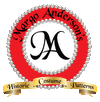I just looked at the calendar and there are only 86 more days till Costume College! Luckily, I've been getting a lot done. Hopefully I'll find time to blog about it as well as do it!
Here's how I've been blinging the gown skirt.
The skirt is trimmed with the 3" metallic trim that I hand painted.
This trim has an iron on backing, but I wasn't about to trust it, since a test swatch peeled off the velvet easily. It did work well for "basting" it in place, though.
I had planned to hand sew the trim, but the iron on backing made it too tough for my arthritic hands. I machined sewed it in place using clear monofilament thread, which blended into the metallic texture so well that's it's only visible from a few inches away.
To attach the ouches, since hand sewing was out, I tried machine sewing, but found that with the thickness of the velvet and the uneven texture of the trim, it was really hard to get the needle aligned just so to sew through the loops of the filigrees. That left one option: glue.
I can hear the purists screaming. "GLUE???"
After all, isn't a glued-together costume the very definition of cheap and tawdry? No, not necessarily. If the technique is well thought out and the right tools and materials are used, it's just as viable a technique as using a sewing machine (and let's not start that debate right now, okay?)
The main thing to determine is what kind of glue to use. I made samples, using the actual dress fabric, the trim, and the same filigree assemblages I'll be using to embellish it, and tried several kinds of glue. Then I let them sit for two weeks. This last is very important, as some glues that seem like they're fine after 48 hours can cure too hard and brittle after a longer period.
When I tested my samples, I found that fabric glues just didn't have what it took to get metal to stick to the velvet and trim. What did work was my old friend E-6000.
In case you're wondering, no, the glue is not dry-cleanable. That ship already sailed when I decided, for reasons of cost and weight, to use plastic pearls. I'll keep this costume clean the way they did in period, by wearing washable linen next to my skin, hanging it (the gown, not my skin) out to air after each wearing, and spot cleaning with water when needed.
I used small syringes to apply the glue very precisely. I wish I'd thought to get some when I was gluing all those ouches together! In order to avoid unforeseen drips getting the glue where it wasn't wanted, I kept my syringes and glue on a separate small table next to my work surface, and any time I brought the syringe over the fabric, I kept a folded paper towel under it.
I embellished the trim by alternating the two kinds of large filigree ouches I made.
I felt it needed a little more so I added large pearls, as well. Half pearls didn't sit well on the trim, and round pearls didn't look good glued, so I hand sewed all 250 of them, stitching into the gaps in the trim pattern.

After I was done, it just seemed to me that a skirt trimmed with gold and silver lace, embellished with hundreds of gold plated filigree pieces and thousands of pearls and rhinestones, seemed a little...plain. It wanted some kind of all over embellishment.
Looking at portraits of the period, I found several showing jewels and pearls applied to the body of the skirt.

I decided to do the same, and ordered another 300 filigrees, this time 1/2" flower shaped ones. I embellished them (of course) with small rhinestones and pearls. Then I marked out a grid on my skirt and glued them on.

I was going to add tiny pearls between the filigrees, but when I tried it, it looked like too much. I think this is Just Right.



Love what you’ve done here! I have rarely resorted to glue but sometimes a girl has to do that! Congratulations on a beautiful gown.
This is MAGNIFICENT. I’m tucking the E-6000 information away for further use! Sometimes it’s just really hard to get something stitched down and looking right, and some sort of adhesive is just right.
I learn so much from you. I also have used E-6000 for jewelry projects never thought about it for fabric. My hands no longer want to do much hand sewing without unbearable cramping.
I learn so much from you. I also have used E-6000 for jewelry projects never thought about it for fabric. My hands no longer want to do much hand sewing without unbearable cramping.
I have been using E-6000 for several (who am I kidding?? A LOT of years) on jewelry projects. Good to know it can hold up on costuming projects as well. Have embellishments to do on my own gowns.
Your gown is beautiful!
Leave a comment